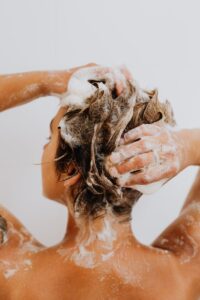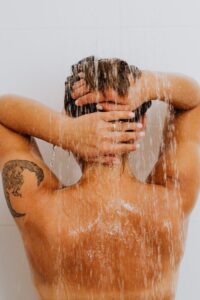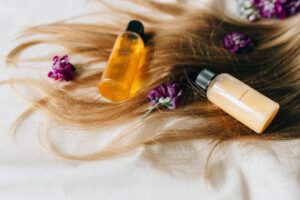Proper Way to Wash Your Hair: Shampoo & Conditioner Guide
At Cameo College, we understand that taking care of your hair is essential for both its health and appearance. Properly washing your hair not only helps maintain its natural beauty but also prevents potential issues such as dandruff and hair loss. While many people wash their hair regularly, doing it the right way can make a significant difference. This guide will walk you through the proper techniques for using shampoo and conditioner, tailored to your unique hair type, to ensure your hair remains vibrant and strong.
Understanding the Importance of Washing Your Hair

Photo by Photo By: Kaboompics.com on Pexels
Washing your hair properly is more than just a routine; it’s a crucial component of effective hair care. The right way to wash your hair involves understanding your hair type and using the appropriate products to keep your hair and scalp clean. Whether you have oily hair that requires frequent washes or dry hair that benefits from less frequent cleansing, understanding these differences is key. A proper hair wash helps remove dirt, excess oil, and buildup of hair products, keeping your hair healthy and promoting hair growth.
Why You Should Wash Your Hair Properly
Washing your hair properly is essential to avoid damaging it. Incorrect washing techniques can strip your hair of its natural oils and lead to hair loss or dry hair. Using the right amount of shampoo and conditioner, and knowing how to massage the shampoo into your hair and scalp can make all the difference. By ensuring you rinse thoroughly, you help prevent the buildup of products that can weigh your hair down and lead to dullness.
Benefits of Clean Hair
Keeping your hair clean provides numerous benefits beyond simply looking good. Clean hair is less likely to harbor bacteria or cause scalp irritation, which can lead to dandruff or other scalp issues. Properly washed hair also tends to be more manageable, allowing you to detangle your hair with ease and style it as desired. Additionally, clean hair and scalp provide an optimal environment for hair follicles, promoting healthy hair growth and preventing issues such as split ends and breakage.
How Often Should You Wash Your Hair?
The frequency of washing your hair depends largely on your hair type and lifestyle. While some people may need to wash their hair every day due to oily hair or exposure to pollutants, others with dry hair might benefit from spacing out their wash days. It’s important to listen to your hair’s needs and adjust your routine accordingly. Using a clarifying shampoo occasionally can help remove any buildup, ensuring your hair and scalp remain clean and healthy without overstripping your hair.
Choosing the Right Products: Shampoo and Conditioner

Photo by Susan Q Yin on Unsplash
How to Select the Right Shampoo
Selecting the right shampoo is crucial to effectively wash your hair and maintain its health. When choosing a shampoo, consider your specific hair type—whether it’s fine hair, thick hair, or somewhere in between. For those with oily hair, a clarifying shampoo can help remove excess oil and product buildup. If you have dry hair, look for moisturizing shampoos that won’t strip your hair of its natural oils. Remember, the right way to wash your hair starts with a product that complements your hair’s unique needs, ensuring each hair wash leaves your hair feeling fresh and clean.
Understanding Different Types of Conditioners
Conditioners play a significant role in hair care, especially when it comes to nourishing and protecting the ends of your hair. There are various types of conditioners, including rinse-out, leave-in, and deep conditioners, each serving different purposes. For daily use, a standard rinse-out conditioner is ideal to apply conditioner primarily to the ends of your hair. If your hair needs extra moisture, a hair mask or deep conditioner can provide intensive hydration. Understanding these differences is key to condition your hair properly and keep your hair healthy and vibrant.
Shampoo and Conditioner Ingredients to Look For
When choosing shampoo and conditioner, it’s important to be mindful of the ingredients to ensure they cater to your hair’s specific needs. Ingredients like keratin and biotin are excellent for promoting hair growth and strengthening hair follicles. For those battling dandruff, shampoos with zinc pyrithione or tea tree oil can be beneficial. Natural oils such as argan or coconut oil can help nourish your hair and prevent it from becoming dry. By selecting products with the right ingredients, you can wash your hair properly, supporting its health and vitality every time you wash.
The Right Way to Wash Your Hair

Photo by Photo By: Kaboompics.com on Pexels
Step-by-Step Guide to Shampooing
Properly shampooing your hair is an essential aspect of maintaining healthy hair and scalp. Start by thoroughly wetting your hair with warm water to open the hair cuticles, which allows the shampoo to penetrate effectively. Use a suitable amount of shampoo based on your hair length and type—whether you have short hair or thick hair, adjust accordingly. Gently massage the shampoo into your scalp using your fingers, creating a lather that effectively cleanses your hair and scalp. Ensure that you distribute the lather evenly, reaching the roots to remove dirt, excess oil, and product buildup. This step not only cleans your hair but also stimulates blood circulation, promoting healthy hair growth.
How Long Should You Leave Shampoo in Your Hair?
Leaving shampoo in your hair for the right amount of time is crucial to achieving a thorough clean without causing damage. Generally, allowing the shampoo to sit for about one to two minutes is sufficient. This timeframe ensures that the active ingredients in the shampoo have enough time to work, breaking down oils and impurities. However, if you’re using a clarifying shampoo or a specialized formula for dandruff, you may need to follow specific instructions on the product label. It’s important not to leave shampoo in your hair for too long, as it can strip your hair of its natural oils, leading to dryness or irritation. Adjust the duration based on your hair’s needs to wash your hair properly.
How to Rinse Your Hair Effectively
Rinsing your hair thoroughly is a key step to ensure no shampoo residue remains, which can weigh your hair down and lead to scalp irritation. Use lukewarm water to rinse, as hot water can strip your hair and scalp of essential moisture. Make sure to rinse until the water runs clear and your hair feels free of any slippery texture from the shampoo. Pay special attention to the roots and ends of your hair to ensure all shampoo is removed. For those with oily hair, a thorough rinse is particularly important to prevent buildup that can make the hair feel greasy soon after washing. Remember, the right way to wash your hair includes rinsing well to keep your hair healthy and clean.
Applying Conditioner Correctly

Photo by Nataliya Vaitkevich on Pexels
When to Apply Conditioner
Applying conditioner at the right moment is crucial to achieving optimal hair health and appearance. After thoroughly rinsing out the shampoo, it’s time to apply conditioner. The key is to ensure that your hair is still damp, as this helps the conditioner spread evenly and penetrate the hair shafts. While you don’t need to apply conditioner every time you wash your hair, incorporating it into your routine regularly can significantly benefit dry hair or hair prone to tangling. By conditioning your hair properly, you maintain moisture balance and prevent damage.
How to Condition Your Hair Properly
To condition your hair properly, begin by taking a sufficient amount of conditioner based on your hair length and density. Use your fingers to distribute the conditioner evenly, focusing primarily on the ends of your hair, where it tends to be driest and most susceptible to damage. Avoid applying too much conditioner to the scalp, as this can weigh down your hair and lead to an oily appearance. Leave the conditioner in for a few minutes to allow it to nourish and hydrate your hair thoroughly, then rinse with cool water to seal in moisture and enhance shine.
Where to Apply Conditioner for Best Results
For best results, apply conditioner starting from the mid-lengths down to the ends of your hair. The ends of your hair are often the most damaged and in need of extra hydration. By focusing on these areas, you help prevent split ends and maintain the health of your hair. Applying conditioner correctly also involves ensuring that it’s distributed evenly to avoid buildup, which can lead to hair feeling heavy or greasy. Remember, the right way to wash your hair includes conditioning to protect and nourish your hair, leaving it soft and manageable.
Special Considerations for Different Hair Types

Photo by pouriya kafaei on Unsplash
Adjusting Your Routine for Thick Hair
If you have thick hair, adjusting your routine is essential to ensure every strand receives the care it needs. Consider using a clarifying shampoo occasionally to remove product buildup and prevent your hair from becoming weighed down. Use a generous amount of conditioner to deeply hydrate and detangle your hair, as thick hair often requires more product to achieve optimal results. By tailoring your hair care routine to accommodate your hair’s thickness, you can maintain its natural beauty and prevent issues such as dryness or frizz.
Washing Curly or Textured Hair
Curly or textured hair requires special care to maintain its natural pattern and prevent damage. It’s often beneficial not to wash your hair every day, as this hair type tends to be drier and more prone to breakage. When you do wash, use a moisturizing shampoo and follow with a rich conditioner or hair mask to deeply nourish your curls. Detangle your hair with your fingers or a wide-tooth comb while the conditioner is still in to minimize breakage. By understanding how to wash and condition curly hair properly, you can enhance its natural beauty and keep it healthy.
Tips for Fine or Oily Hair
Fine or oily hair presents its own set of challenges that require a tailored approach. Opt for a lightweight clarifying shampoo to effectively cleanse your hair without stripping it of its natural oils. When applying conditioner, use a small amount and focus only on the ends of your hair to avoid weighing it down. Frequent washing might be necessary for oily hair, but be mindful of the products you use to maintain balance. By adjusting your routine according to your hair’s needs, you can keep fine or oily hair looking fresh and voluminous.

